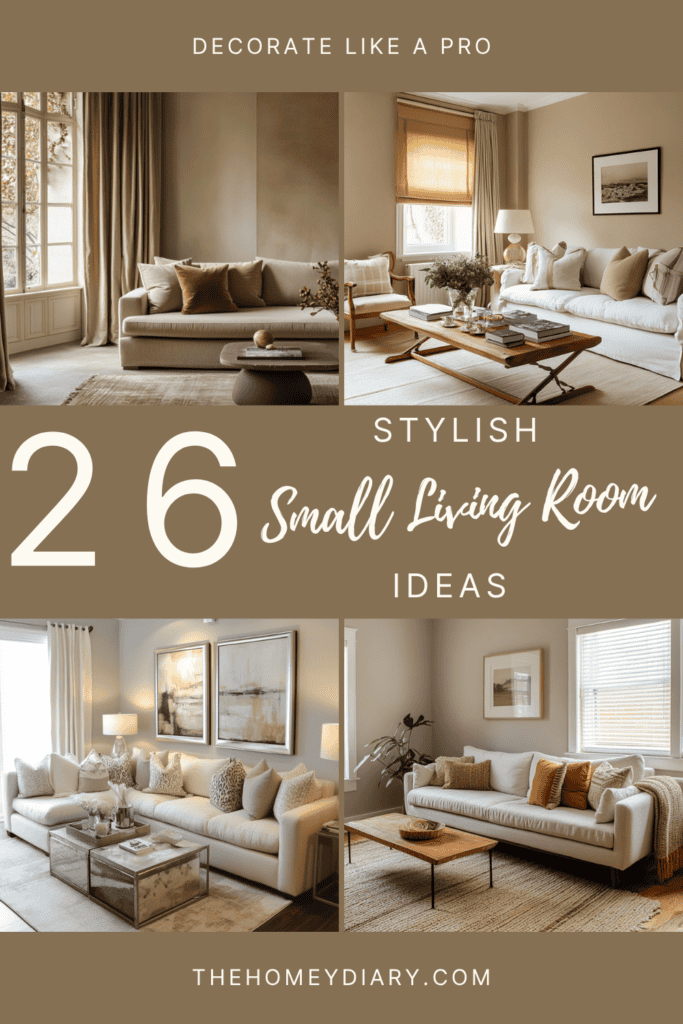
Small living rooms create unique design challenges, but usually none that a different paint color, new furniture layout, or simple architectural feature can’t solve. Remember, we’re short on square footage, never on ideas. Just a bit of creativity and some smart planning is all you need to design a space that feels big on comfort, style, and personality, even if it’s technically pint-sized!
Excited? We are, too. Let’s dive right in.
Choose One Sectional Over Multiple Seats
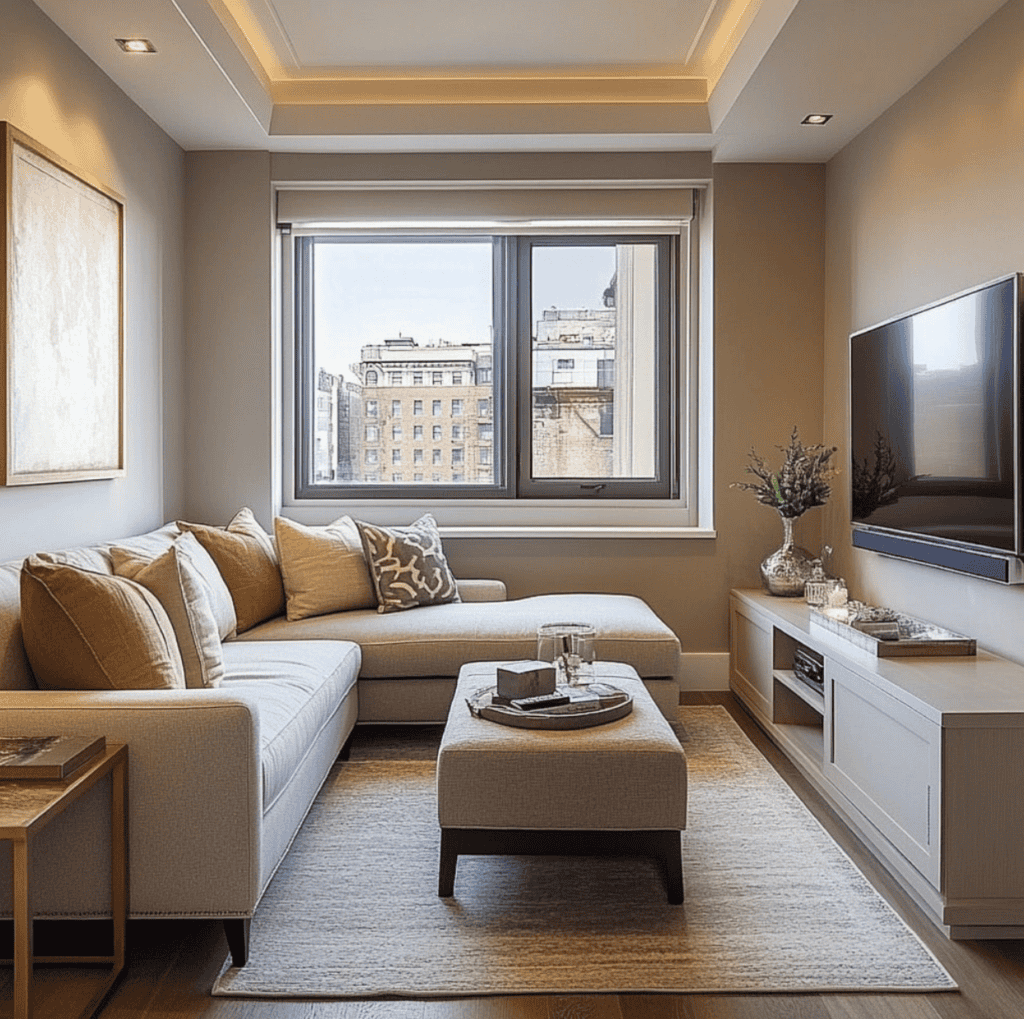
Sometimes, bringing in multiple seating options in a small living room can feel awkward, so opt for a single, sleek sectional instead. Notice how the neutral-tone sectional here hugs the corner perfectly, leaving the rest of the room open and airy. It defines the space without crowding it. To keep it feeling even lighter, stick to soft, warm hues like beige, cream, or taupe.
Limit the Color Palette
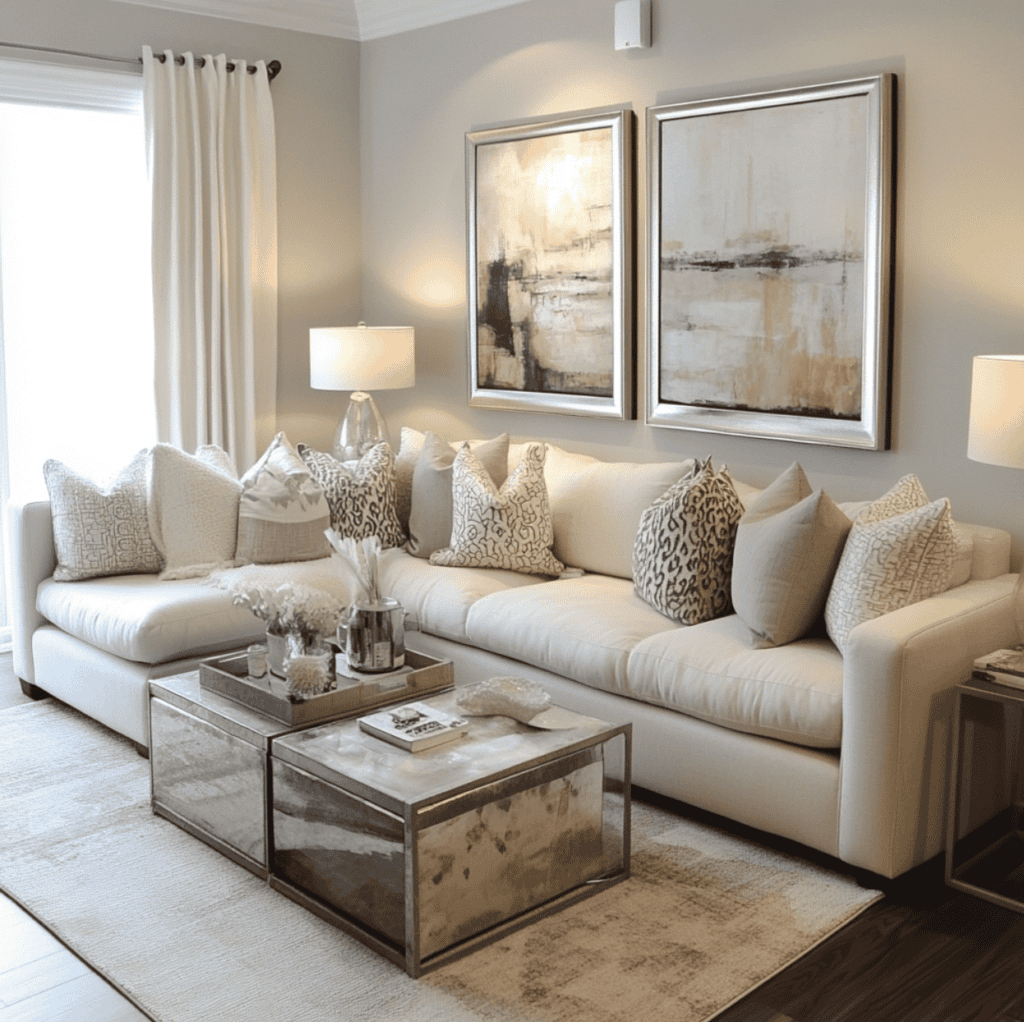
Stick to a toned-down, limited color palette when decorating a small living room. The primary thing to remember is to ensure all shades follow the same scheme, thus creating flow throughout the room. And don’t forget to shift your focus around tonal and monochromatic hues that accentuate the palette further.
Select an Anchor Piece
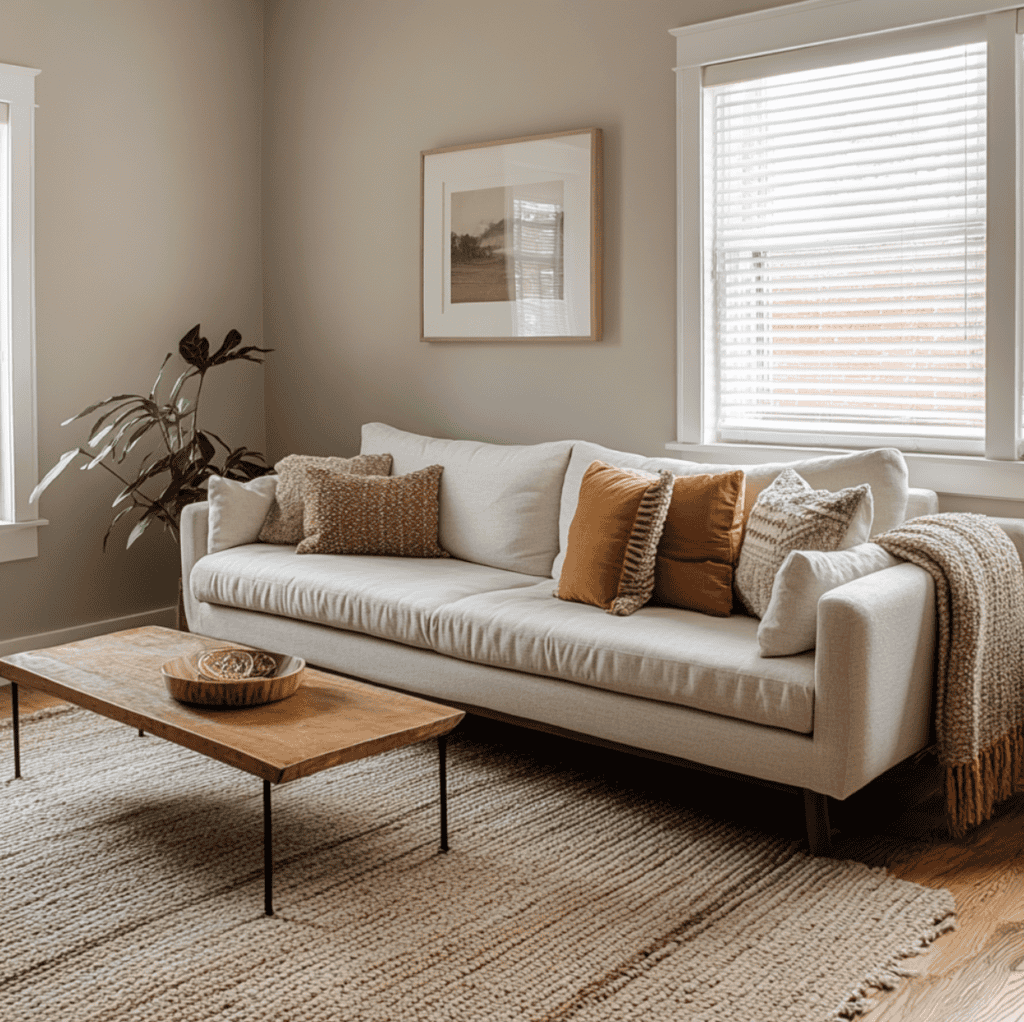
Every small living room needs a hero, and no, we’re not talking about your remote. We mean an anchor piece that grounds the space and gives it visual weight… could be a statement sectional, a chic area rug, or even a bold piece of wall art.
In this space, the soft beige rug works quietly in the background, pulling everything together without stealing the spotlight. And if you’re not quite ready to invest in a statement rug, your wall art can take the lead too!
Use Mirrors Wherever Possible
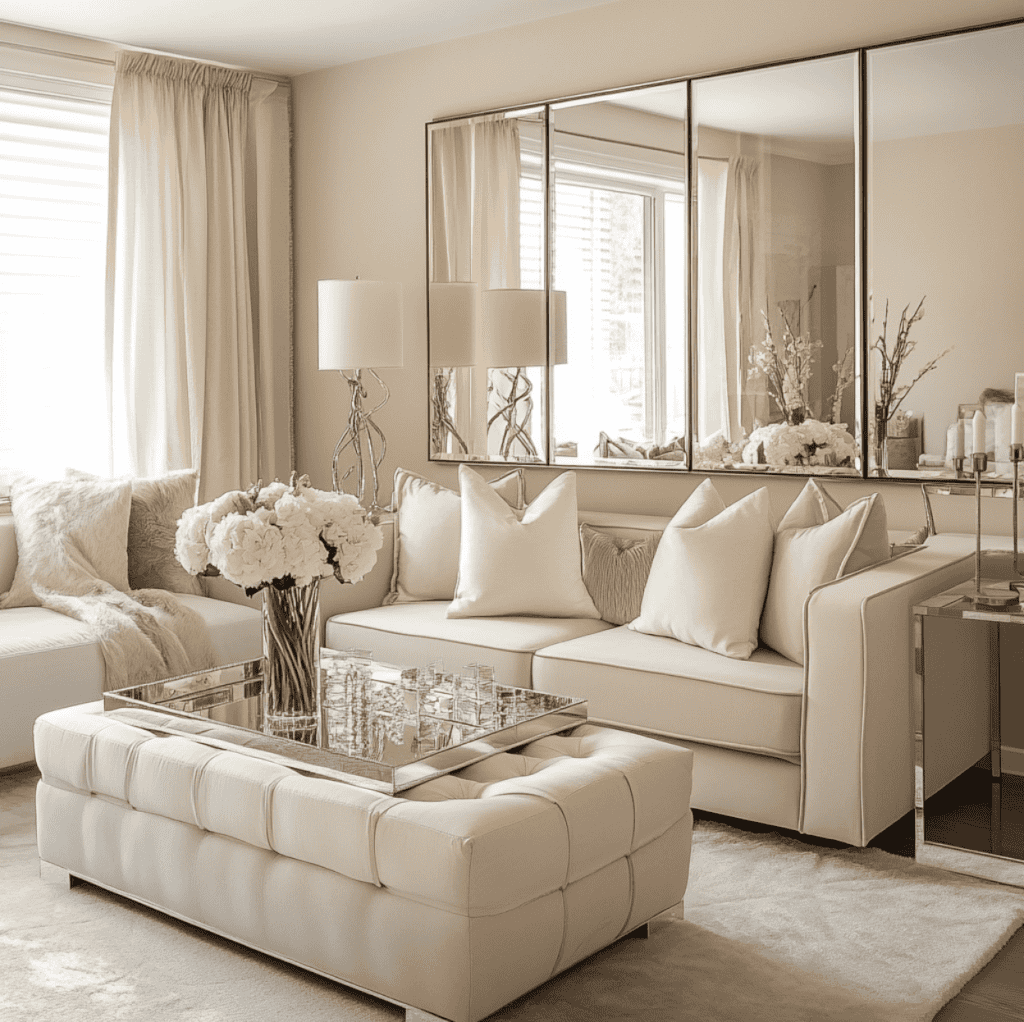
Mirrors are pure magic, especially in small living room decor. Try placing one opposite a window to double natural light, and also near lamps or sconces to enhance artificial lighting.
Mirrored furniture is another smart move. Think console tables with reflective surfaces or mirrored trays on your ottoman. Simple, budget-friendly ways to bring in a bit of shine while helping your small space look (and feel) more open.
Use Tall Vertical Shelves
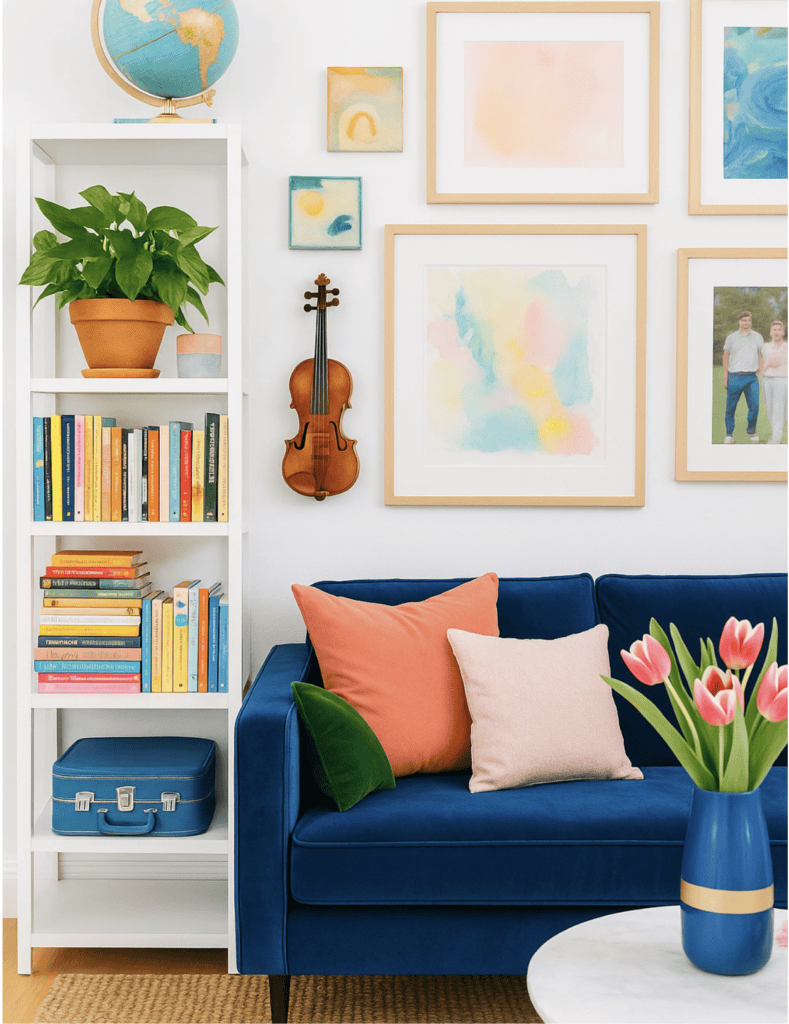
We’re utilizing every inch of the room, including the walls. Tall shelving units, like the one in the image, are lifesavers in tiny living rooms. It’s painted in white to blend it into the wall, and styled with lovely, minimal decor to show that aesthetics don’t have to be sacrificed for practicality. And let’s not miss the suitcase at the bottom; hidden storage that looks super cute. Opt for vertical shelves with open sides, and you can keep your coffee and phone within arm’s reach when lounging. Even better, double the shelf as a divider to create zones in your open living plan!
Paint Bold Trim
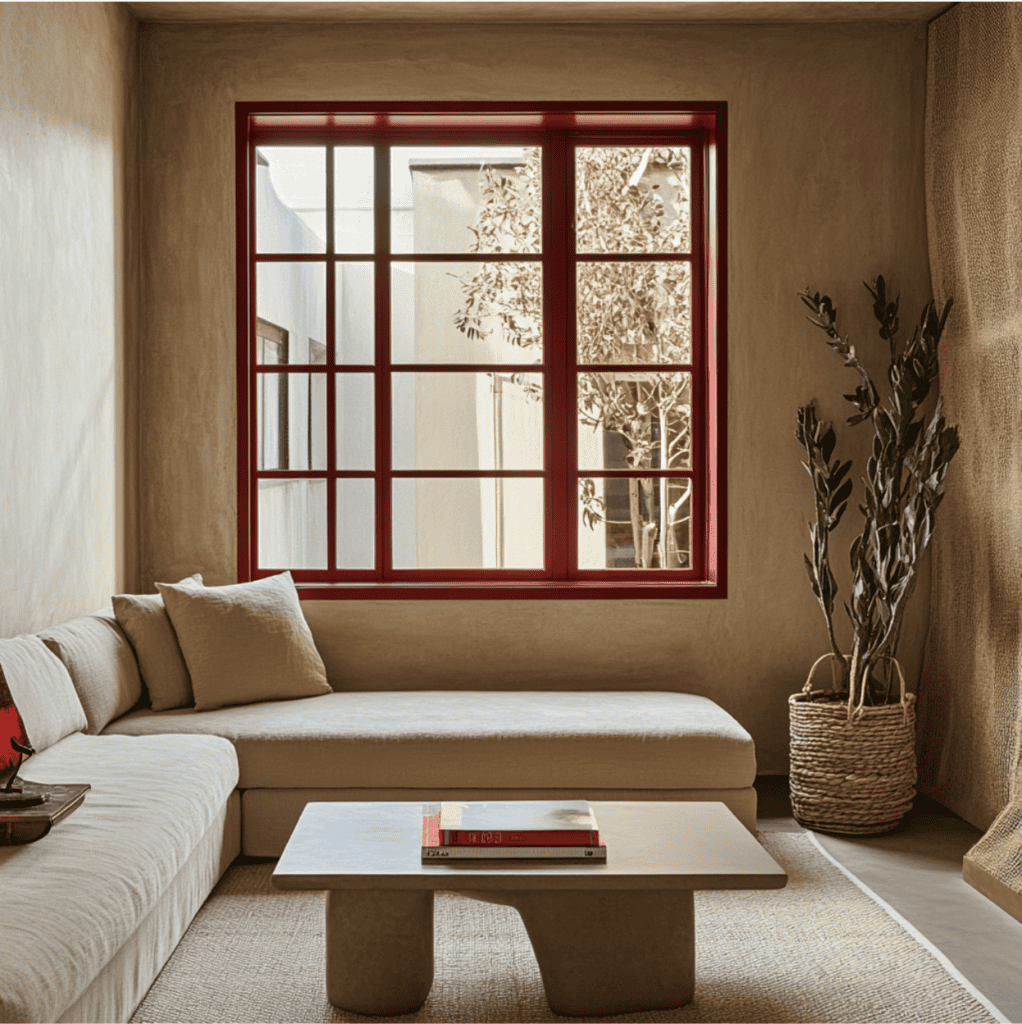
We understand the urge to paint a small living room in a neutral shade to make the space feel a bit bigger, but we’re begging you not to skip color altogether. Follow the footsteps of this homeowner and choose a bold paint hue for the trim to introduce some personality.
Arrange Furniture Efficiently
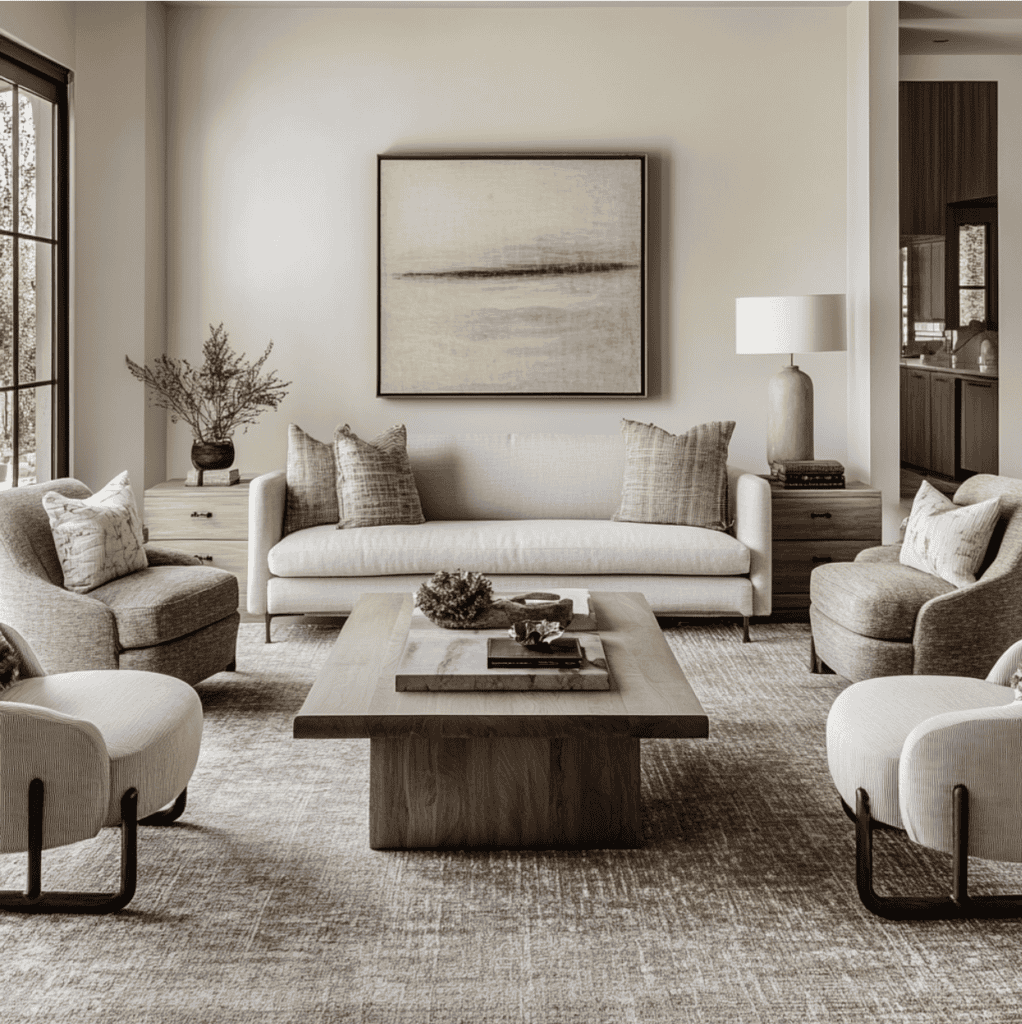
The right furniture arrangement is the secret to opening up a small living room. Though pushing furniture against the walls seems like it would maximize space, such a layout actually makes the room feel boxed in. Instead, “float” the furniture, meaning pull it away from the walls toward the center of the room to design a cozy conversation area. Leaving extra space behind the furniture for moving around helps improve the tiny room’s open elements, including the large window and the elegant entryway.
Layer the Lighting
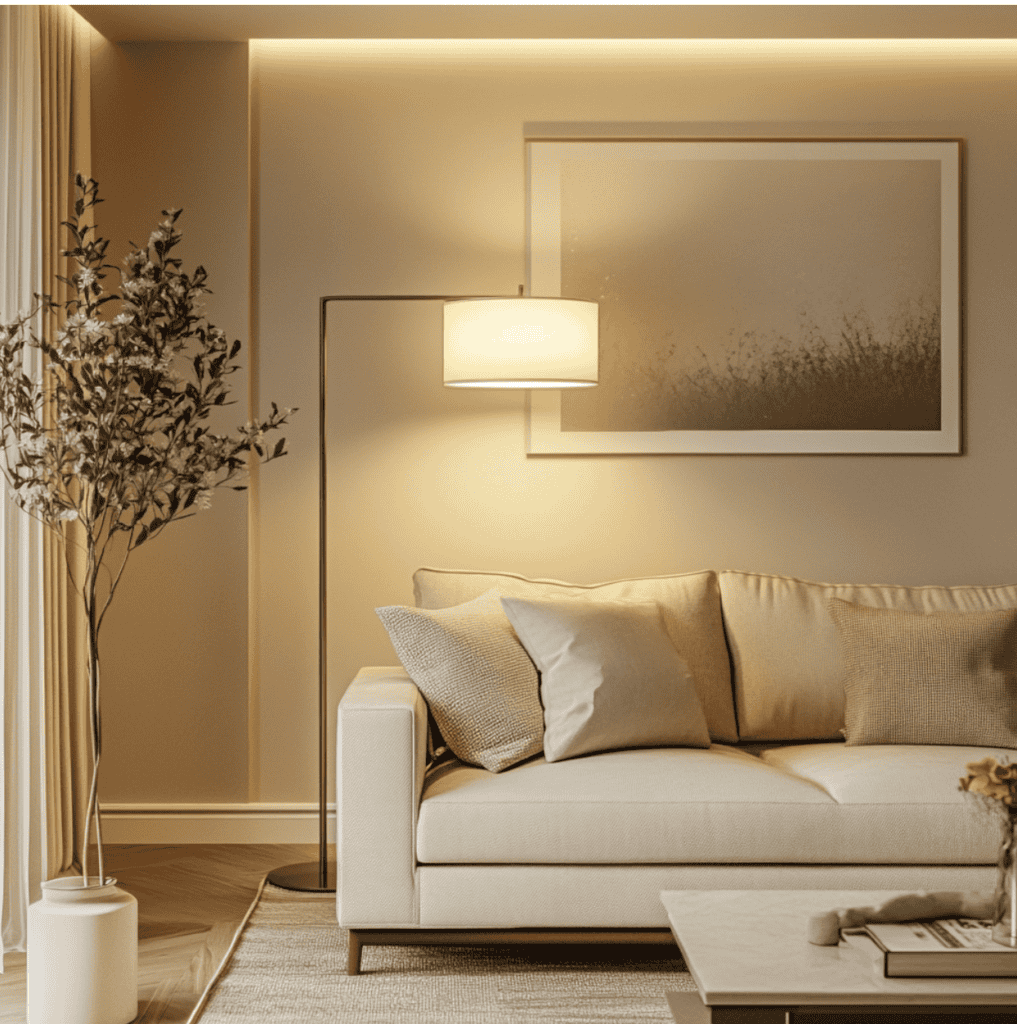
Layer your small living room lighting for a functional space with an inviting ambiance.
Mount a pendant light overhead with dimmable control and add lots of wall lights and lamplights to complete the look. Opt for shades that can both create pools of light for the atmosphere and direct light for tasks like reading. Installing wall lights that reflect soft shafts of light up and down will also give the illusion of a taller ceiling.
Play with Contrast and Shine
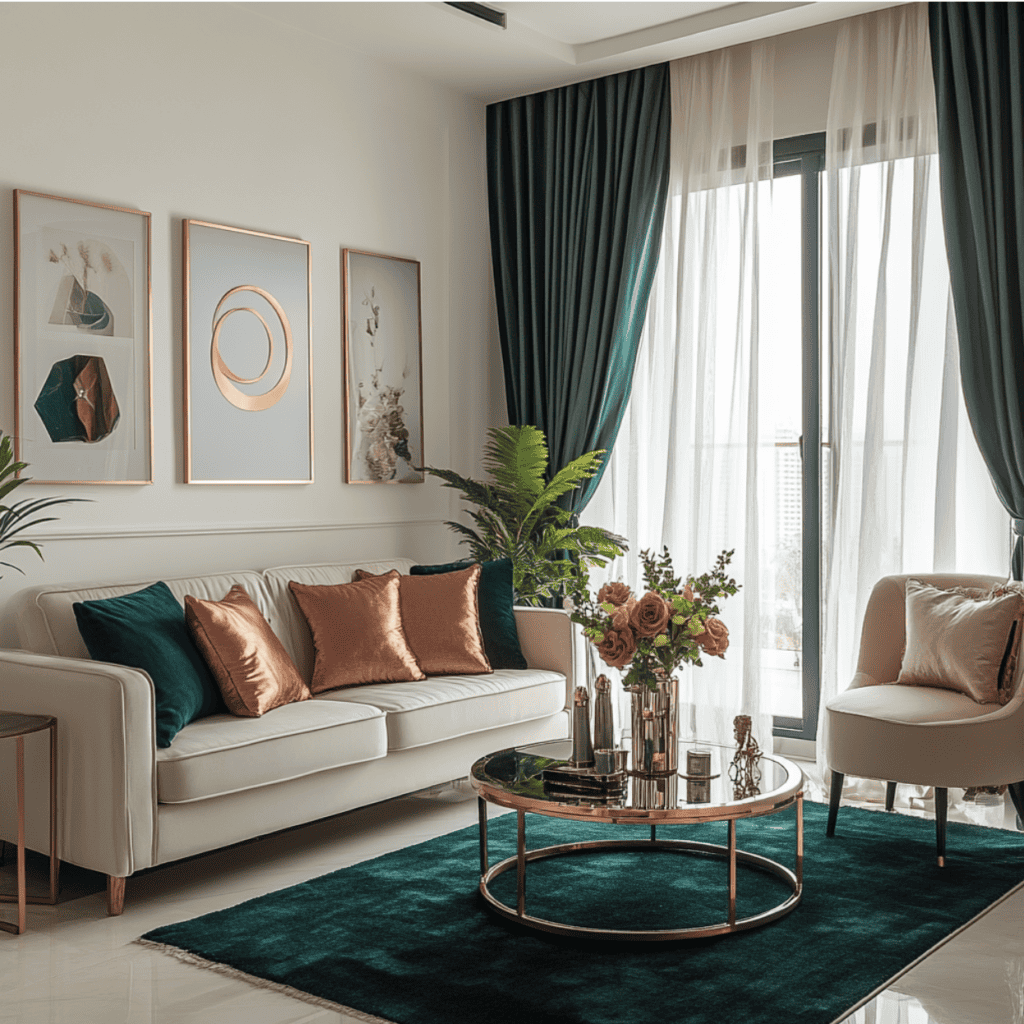
You don’t need a big room to make a bold statement. Pairing deep, dramatic hues like emerald green with warm metallics like copper or gold instantly adds dimension. The trick is to balance that boldness with lighter, more neutral backdrops (think off-white walls or a cream sofa) to keep things from feeling too heavy.
And don’t shy away from a little shine! Metallic finishes on accent pillows, mirrors, or coffee tables can bounce light around the room and add a glam edge without taking up extra space.
Create a Tonal Look
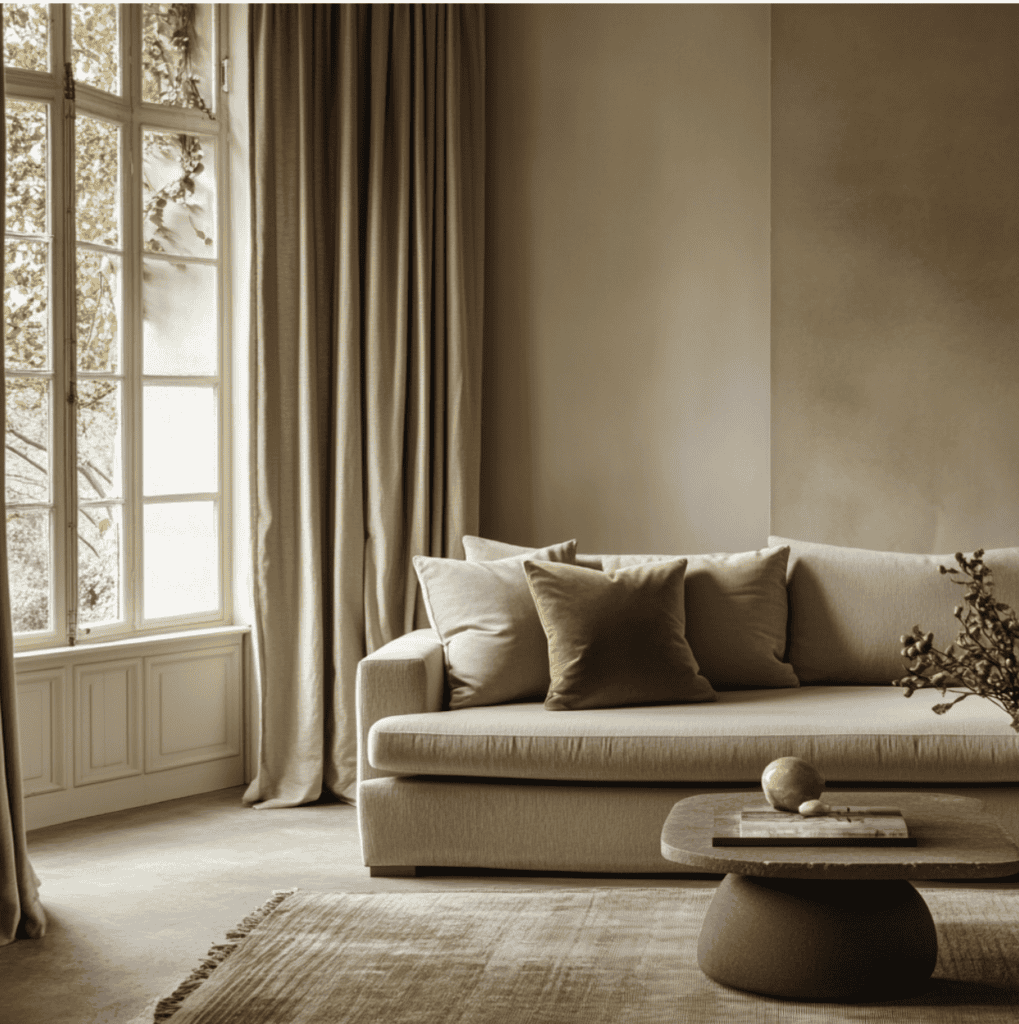
A tonal look uses three shades of the same color on furniture, walls, and decor to give your small living room variation while remaining cohesive. The purpose is to layer light to dark tones of the same hue. Here, the interior incorporates shades of taupe (on the sofa), sandy hues (on the curtains), and caramel-inspired tones (on the cushions) to design a space that’s toned down but super cozy.
Hang Smaller Artwork
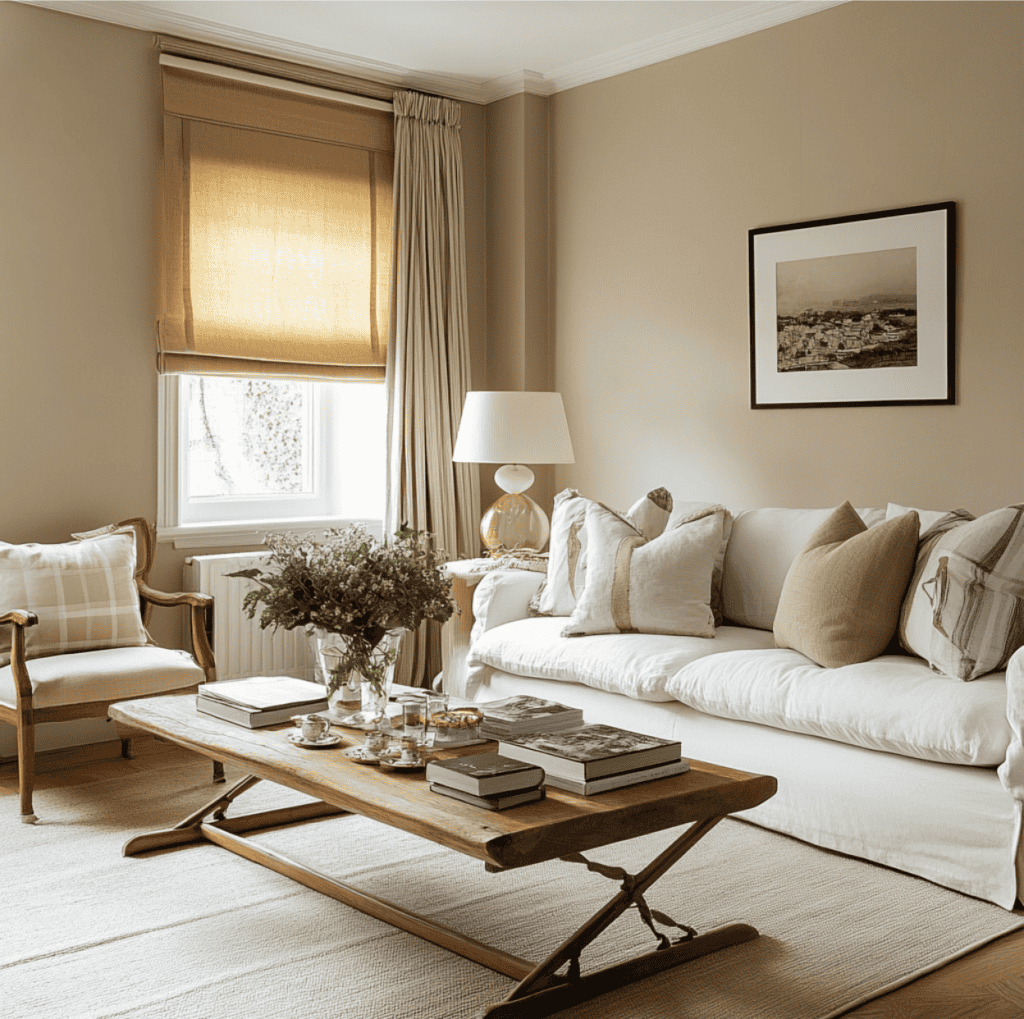
When space is tight, think small, but smart. Oversized art can overpower a petite living room, while smaller, well-placed pieces (like the framed photo in this image) add just the right amount of visual interest. Or, you can even group a few smaller frames together for a gallery look that adds charm (and dimension) without eating up wall space. The point is to always choose pieces that are meaningful and tie the room together, instead of competing with the rest of the decor.
Go for Fewer, High-Quality Pieces
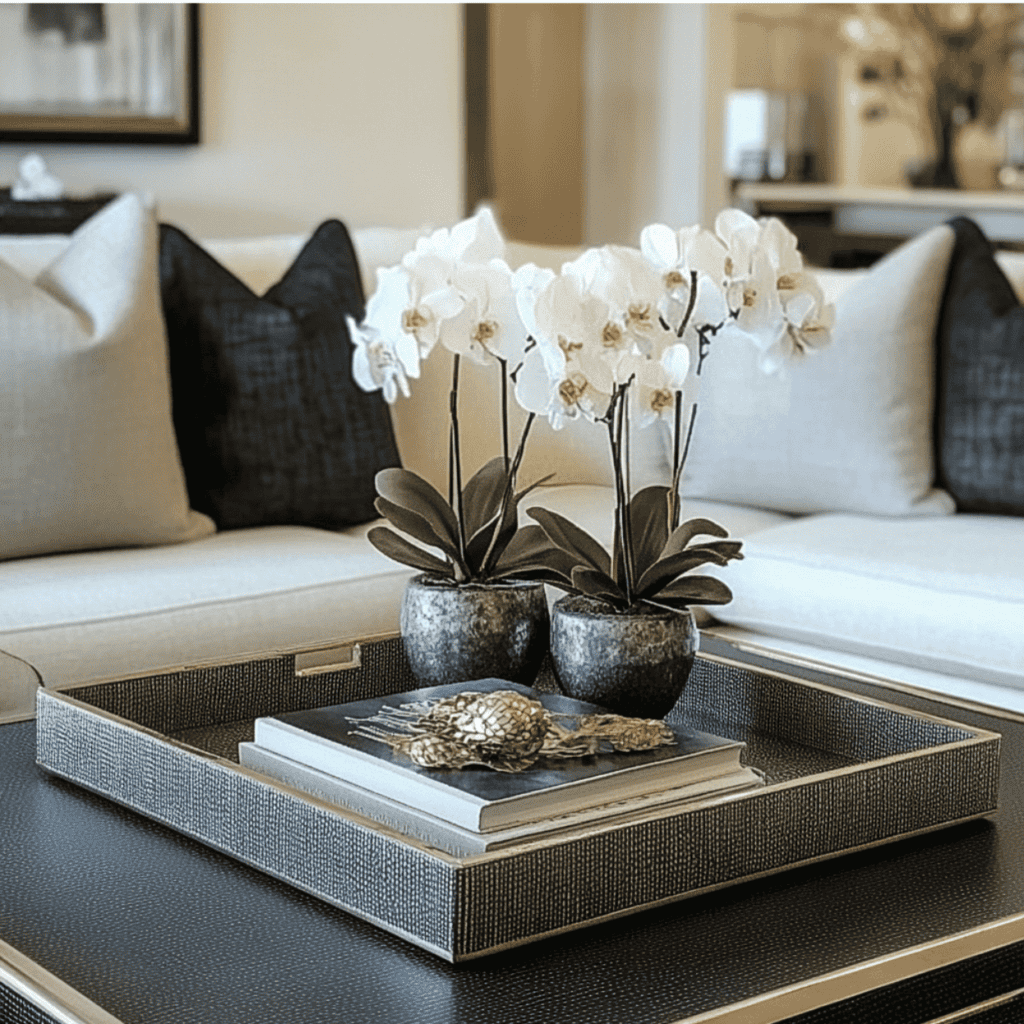
Less is more in a small living room. Instead of cramming the space with lots of little items, choose a few standout pieces that feel truly intentional. Take the sleek coffee table in this image, for example. Styled with a textured tray, elegant books, and a simple pair of orchids, it’s proof that you don’t need much to make an impact. Quality pieces tend to have cleaner lines, better finishes, and a timeless appeal, so even if your space is small, it feels refined and well thought out.
Use a Two-Tier Coffee Table
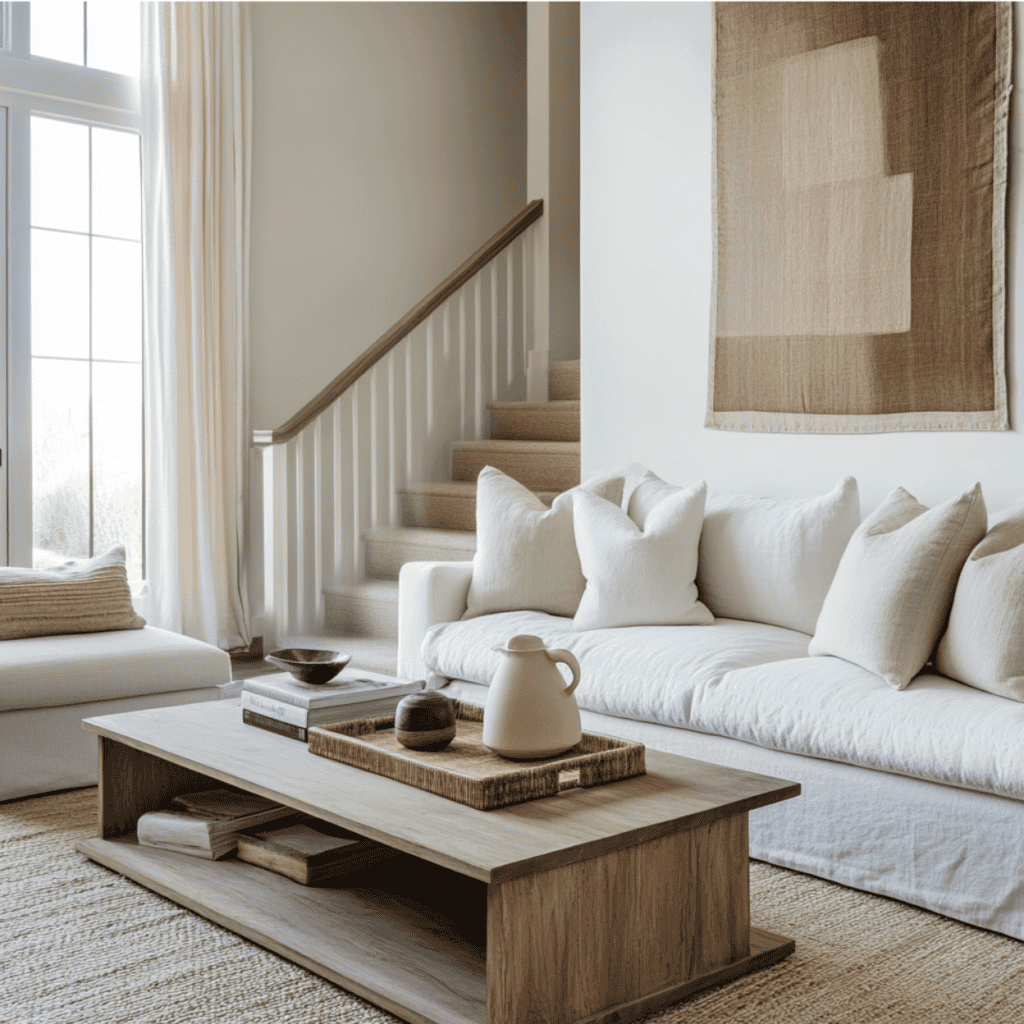
Give your coffee table some much-needed breathing room, and your books & decor pieces some extra storage space with a two-tier design. Just like that, an ottoman with storage would be a great addition as well. Extra seating space, enhanced aesthetics, and more storage, all in one!
Want to know more about small living room storage? We have a full post about it.
Hang the Curtains High
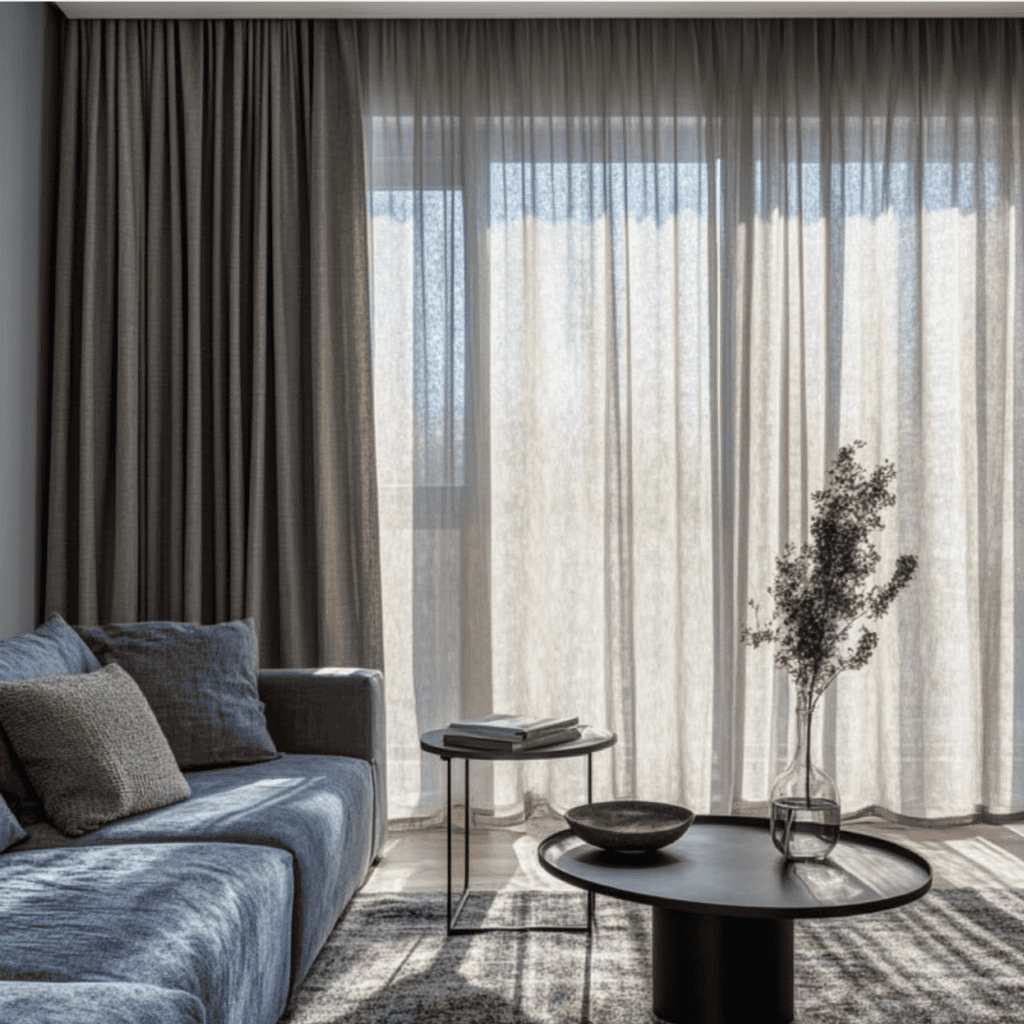
There’s a reason why designers always encourage their clients to hang their curtains higher and wider than the windows themselves. It makes your windows, and room in general, feel much bigger. Always use this optical illusion to your advantage, particularly in a small living room.
Minimize the TV
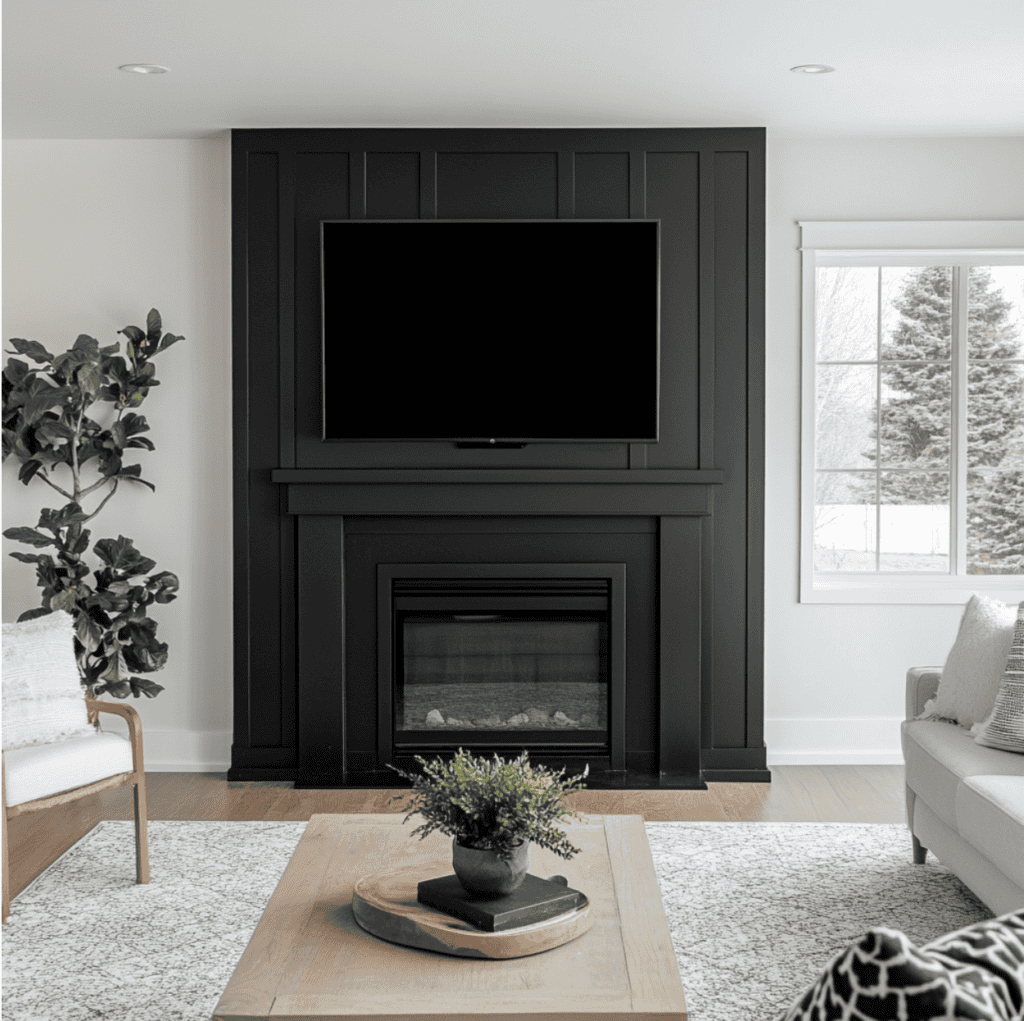
It’s hard to ditch the TV because, of course, it’s the main source of entertainment in the living room… and so, we’ve come up with a much better idea: hiding the TV by painting its background in a dark hue. Works incredibly well, adds a pop of color, and looks absolutely stunning.
But if you’re not ready for such a bold decision, entirely removing the TV could be an option too. Simply use a portable projector to watch movies and shows whenever you’re in the mood.
Paint the Ceiling
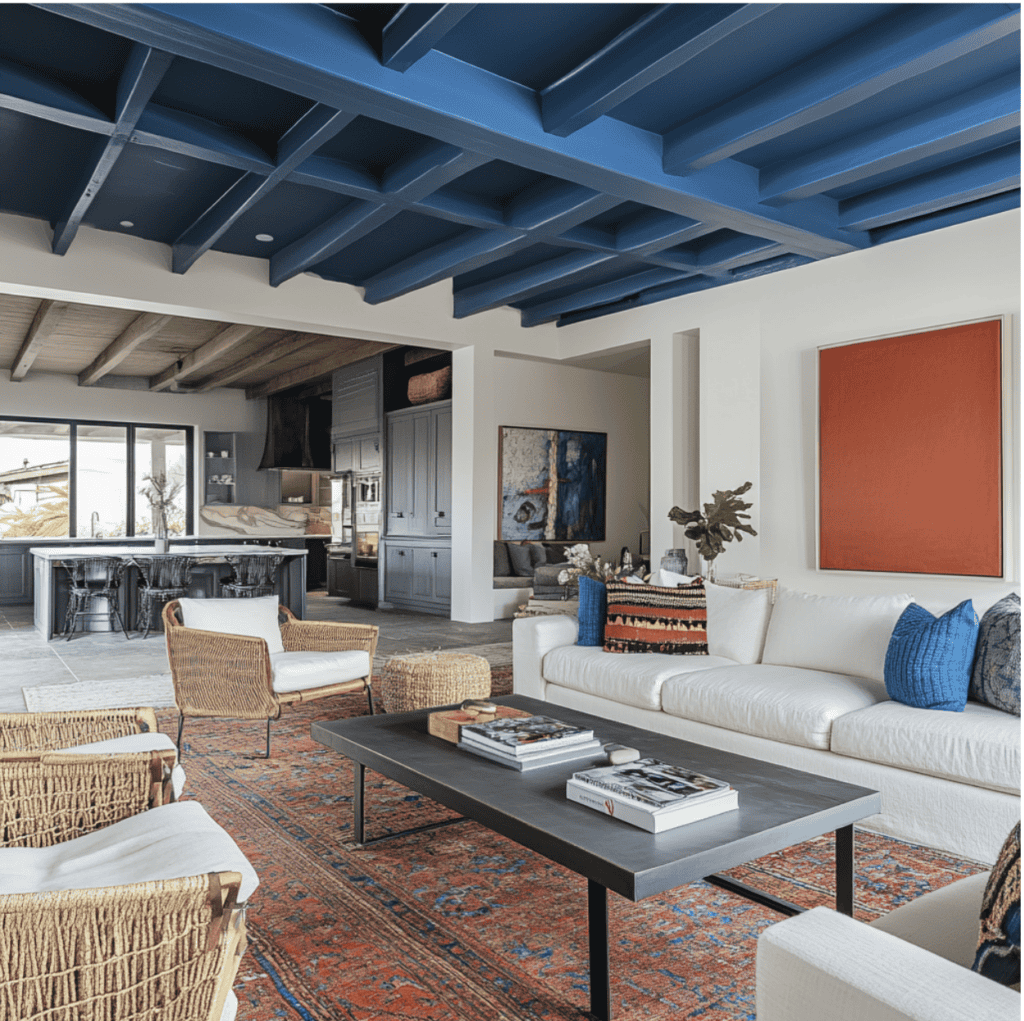
Since much of this house features an open floor plan, the designer made sure to differentiate this small living area by painting the ceiling in a refreshing blue hue to section off the space. The sleek, low-profile furniture makes the room appear higher than it is, and the blue-orange rug beautifully complements the bold hue of the ceiling.
Install Open Shelving

Think vertically when short on space. Floating shelves, for example, are a wonderful addition to a minimal living room. And, if planned carefully, they can even double as decor, as seen in this image, where a metallic black shelf lends to the overall aesthetic while holding a few curated pieces that introduce charm without clutter.
Vary Furniture Heights
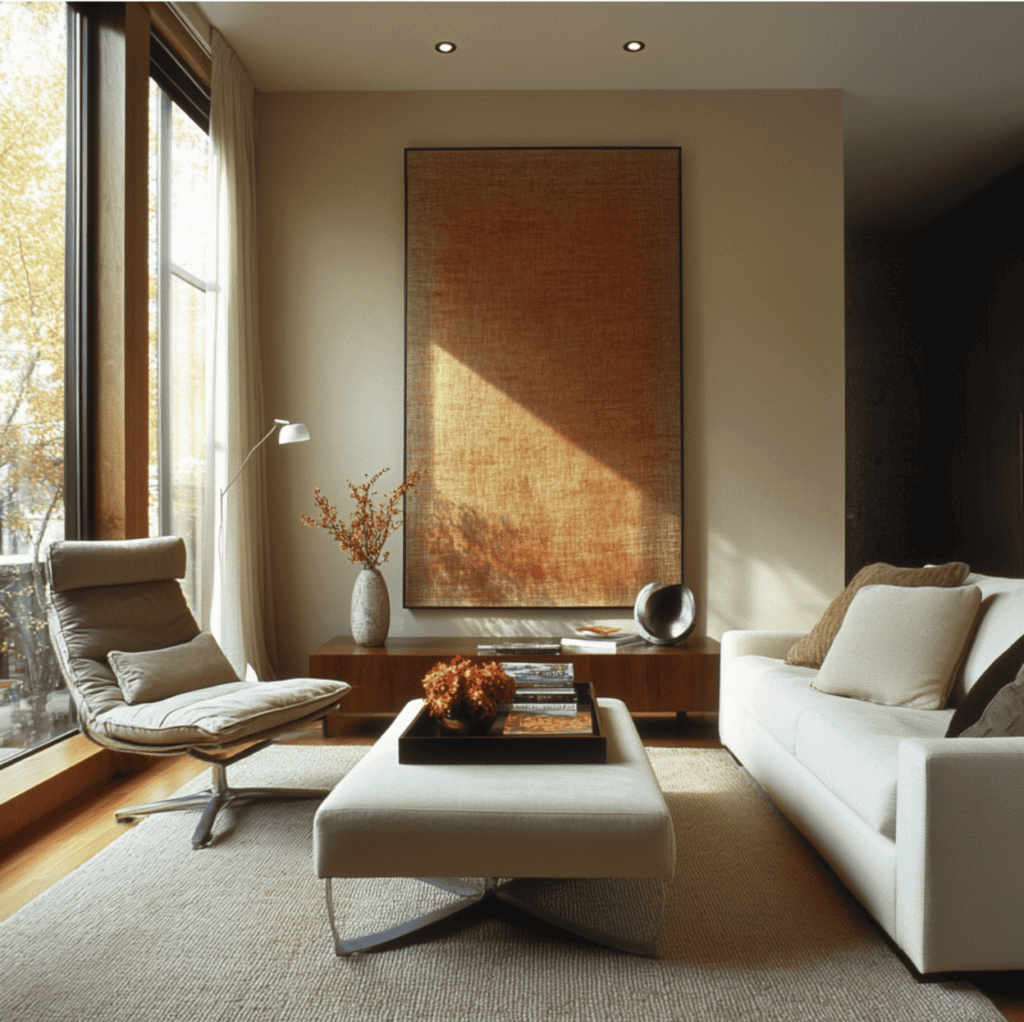
Opt for furniture with varying depths and heights to give your living space a sense of dimension, helping it feel more interesting. Consider a low ottoman contrast with a taller lounge chair. Add oversized vertical artwork to finish the interior with something that pulls the eye upwards.
Keep The Flooring Light

A golden rule for small living room flooring: go light. Lighter floors, especially in neutral tones, reflect more light and help the room feel bigger, brighter, and more breathable.
For wood or wood-look options, think white oak, birch, or even maple. If you prefer something other than wood, light-toned tiles like beige limestone or soft sandstone will do the job. Or, perhaps, you might not be planning a major reno. No problem. Just layer a light area rug over your existing flooring. Something in ivory, cream, or soft taupe can instantly lift the whole room (and create the illusion of more space!). No contractor required 😉
Work Those Weird Angles
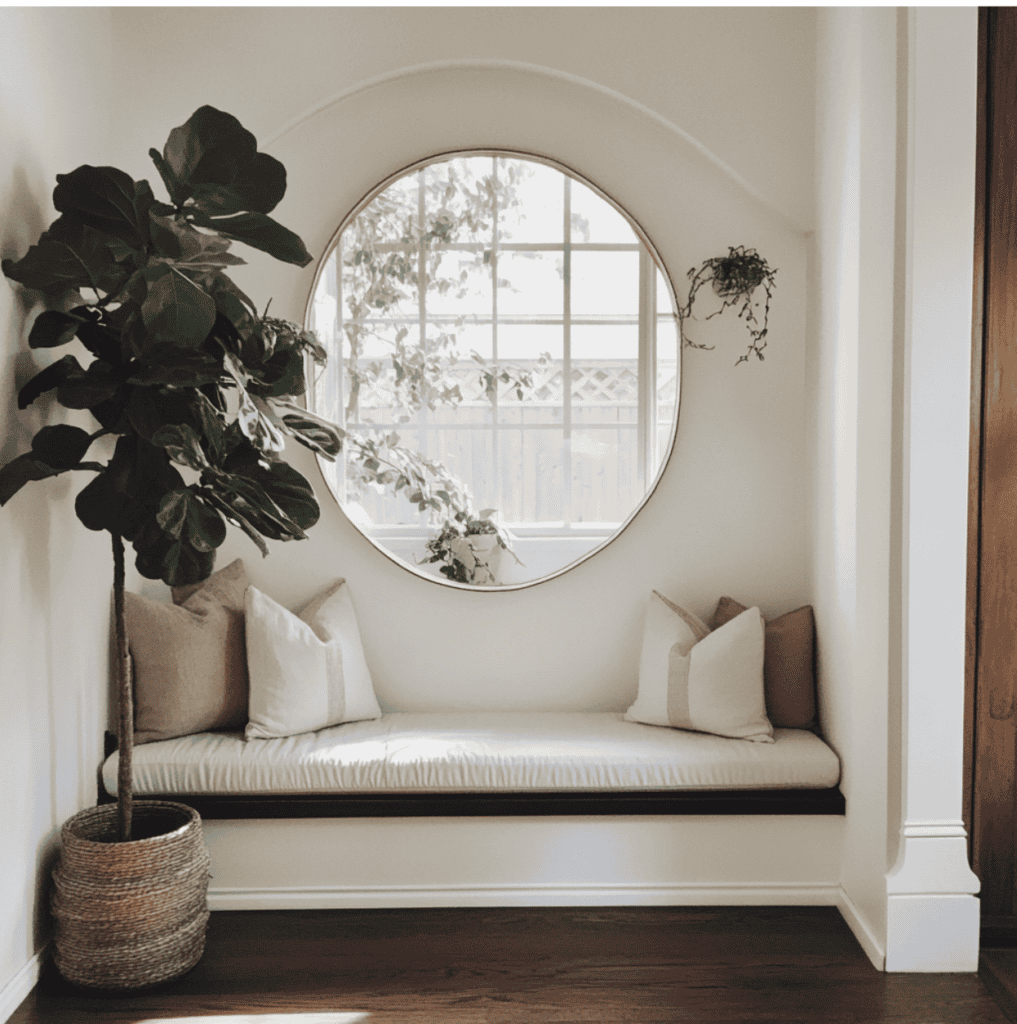
An awkward nook in a living room that’s already tight on square footage? An absolute nightmare, but not a dealbreaker. It’s actually the perfect opportunity to get creative. Just look at this cozy built-in bench moment. The designer turned a tricky alcove into a dreamy little retreat with minimal effort. Add a cushion, a few throw pillows, maybe a mirror or some greenery, and suddenly, that awkward spot becomes a design highlight. Simple. Affordable. Perfect.
Optimize Natural Light
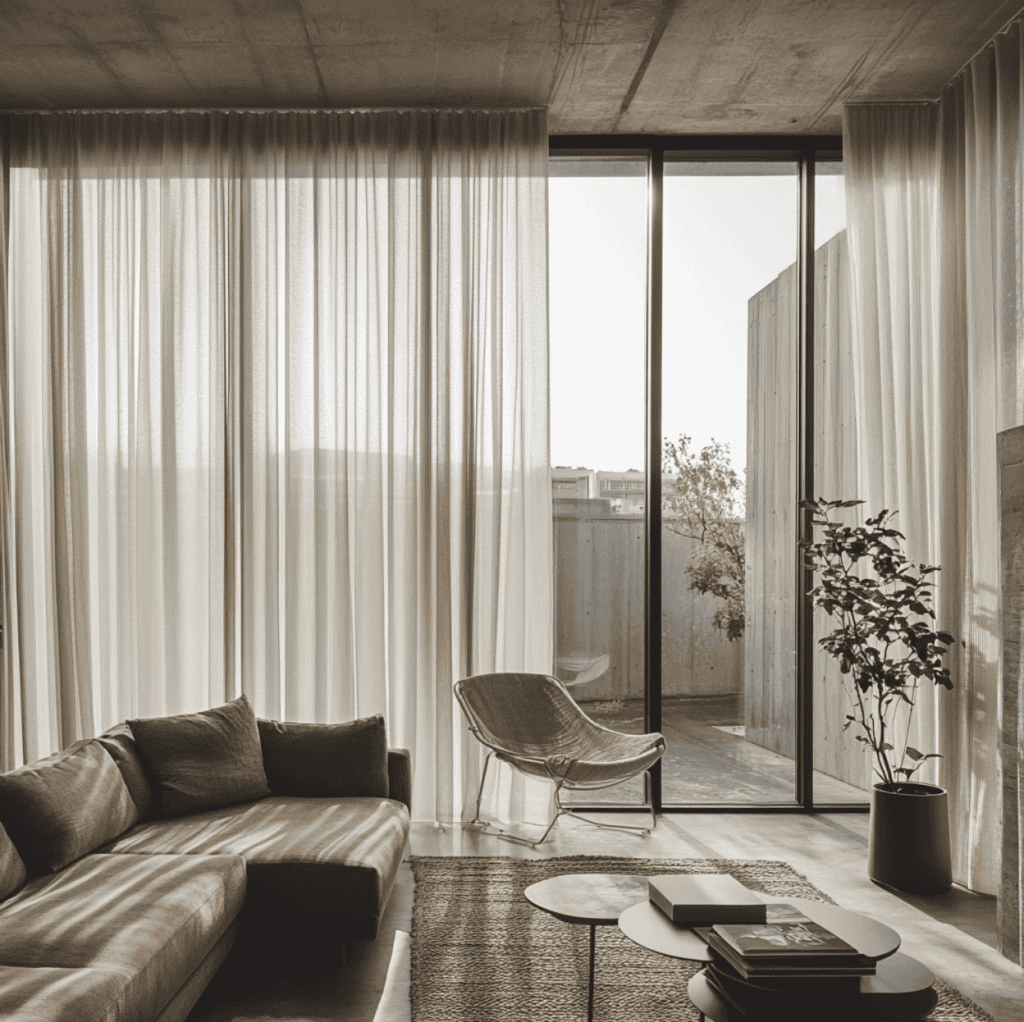
Smaller living rooms can appear bigger when flooded with natural light. Though floor-to-ceiling windows are an incredible option, they might not be on your cards. Simpler solutions, like sheer curtains or even regularly cleaning the windows (and windowsills), can do wonders.
Add Your Personal Style
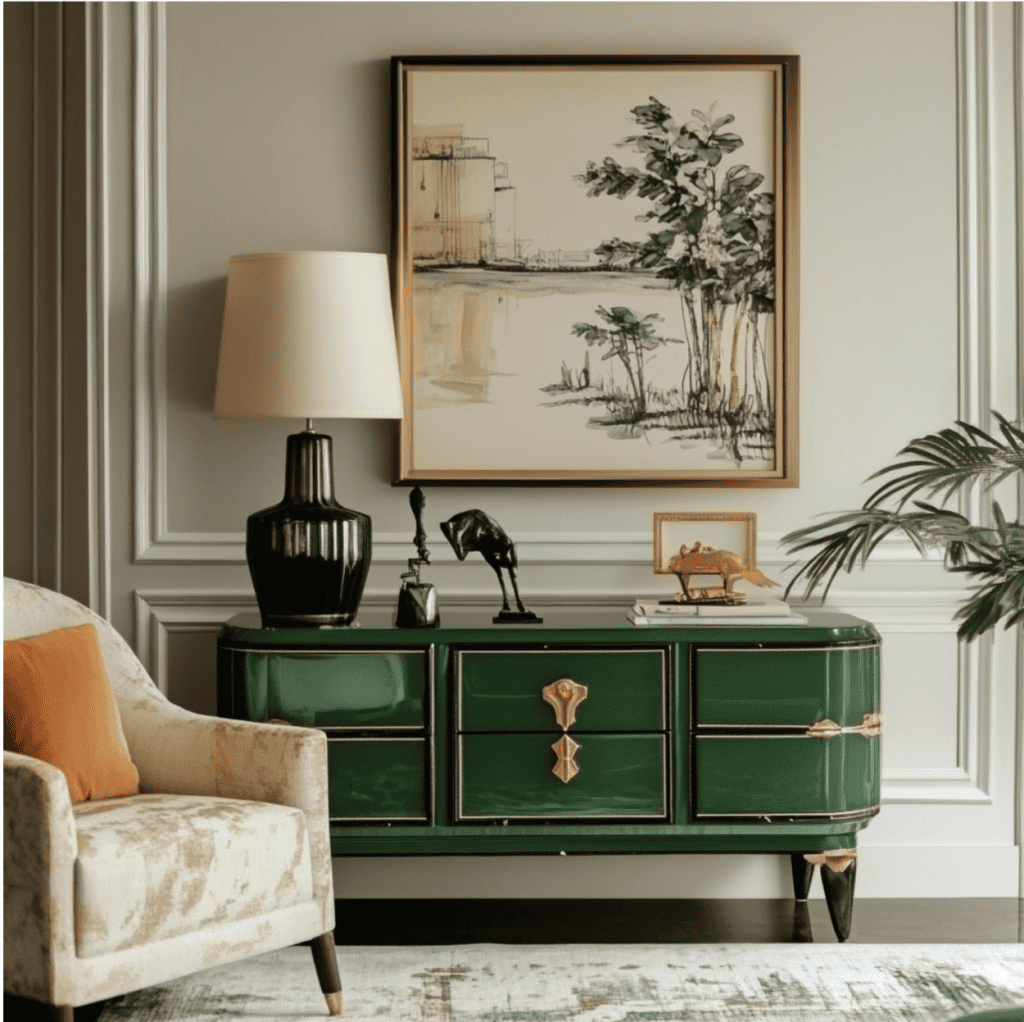
You don’t need to sacrifice style when it comes to small living room ideas. The trick is to tone down the amount (and size) of furniture and decor so they don’t overpower the space. Begin with a couple of right-sized furniture pieces, then layer in a thoughtful collection of accessories to introduce texture. The green-painted console table is a bold statement among the subdued colors, which commands instant attention and beautifully reflects the homeowner’s taste.
Establish a Soft Background
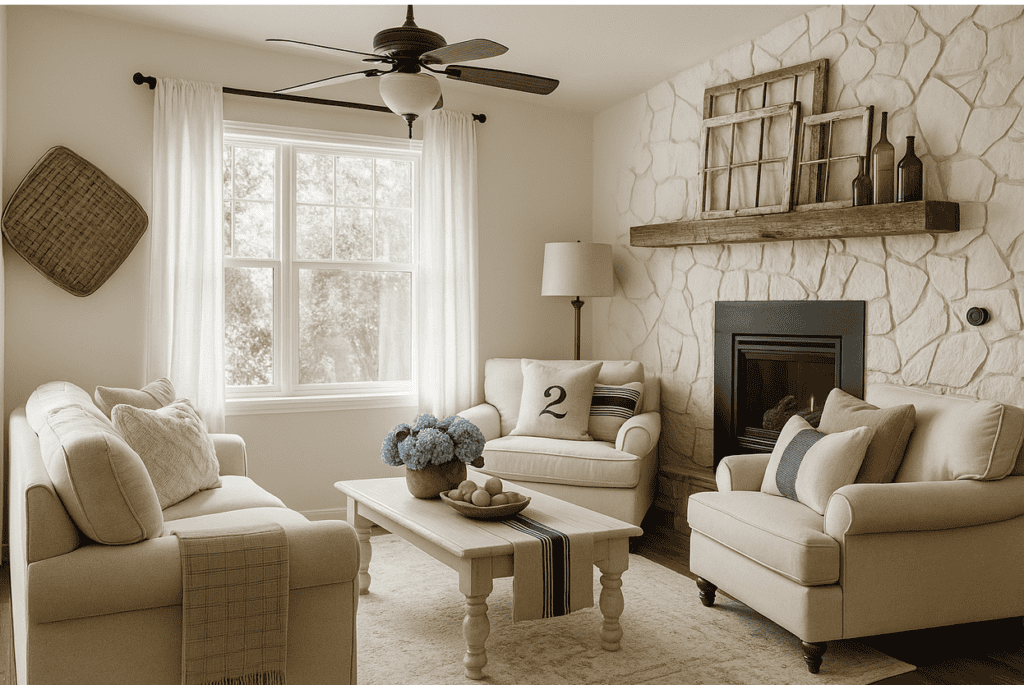
Visually fade the perimeter of your tiny area for an expansive small living room idea. To recede the walls into the background, paint the trim, walls, and ceiling in the same shades of white. For the windows, try sheer curtains that match the background and allow maximum light. This tidy room has a relaxed feel because of the monochromatic scheme.
Small Living Room Idea with Books as Decor
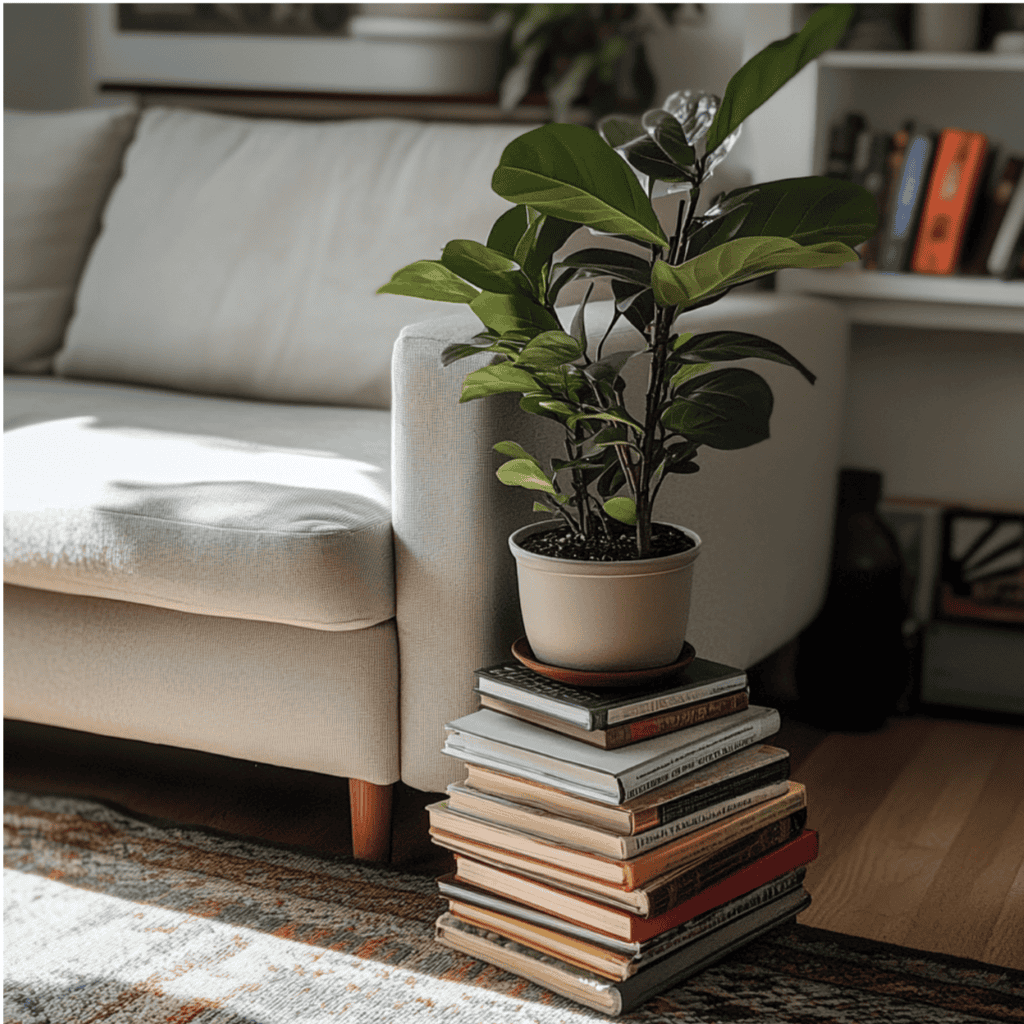
Before you go purging your books to fit into your mini bookshelf in your tiny living room, try shifting some of them off the shelf and into your decor. If you don’t have room for your stunning coffee table books on your actual coffee table, they may just serve as the perfect plant stand.
Incorporate Negative Space
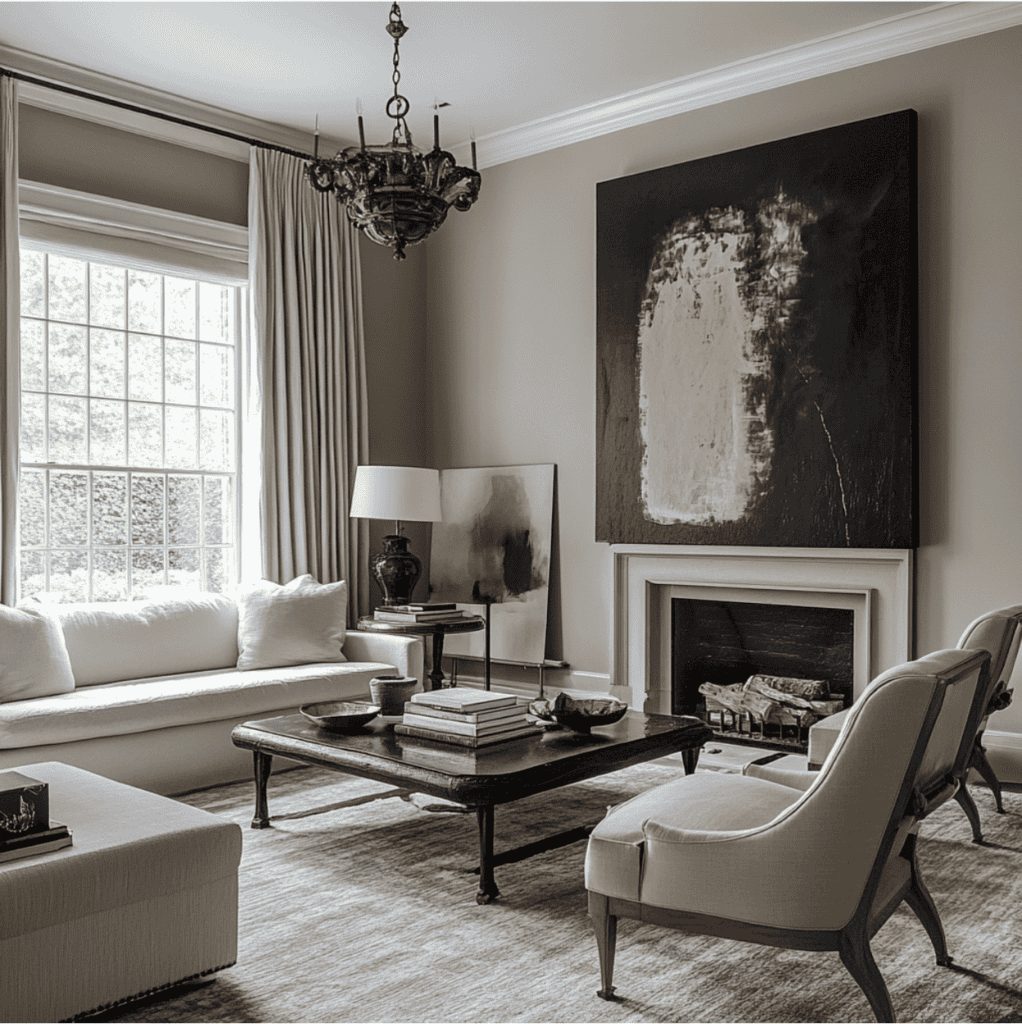
Incorporate blank (or negative) space in a living room that allows it to breathe. Remember, efficient use of space is the most important element in designing a small living environment. Although it’s tempting to use every square inch available, maintaining good balance with open, empty space is the secret to designing a personal, high-functioning design that offers both visual appeal and comfort.
Picture Frame Moldings
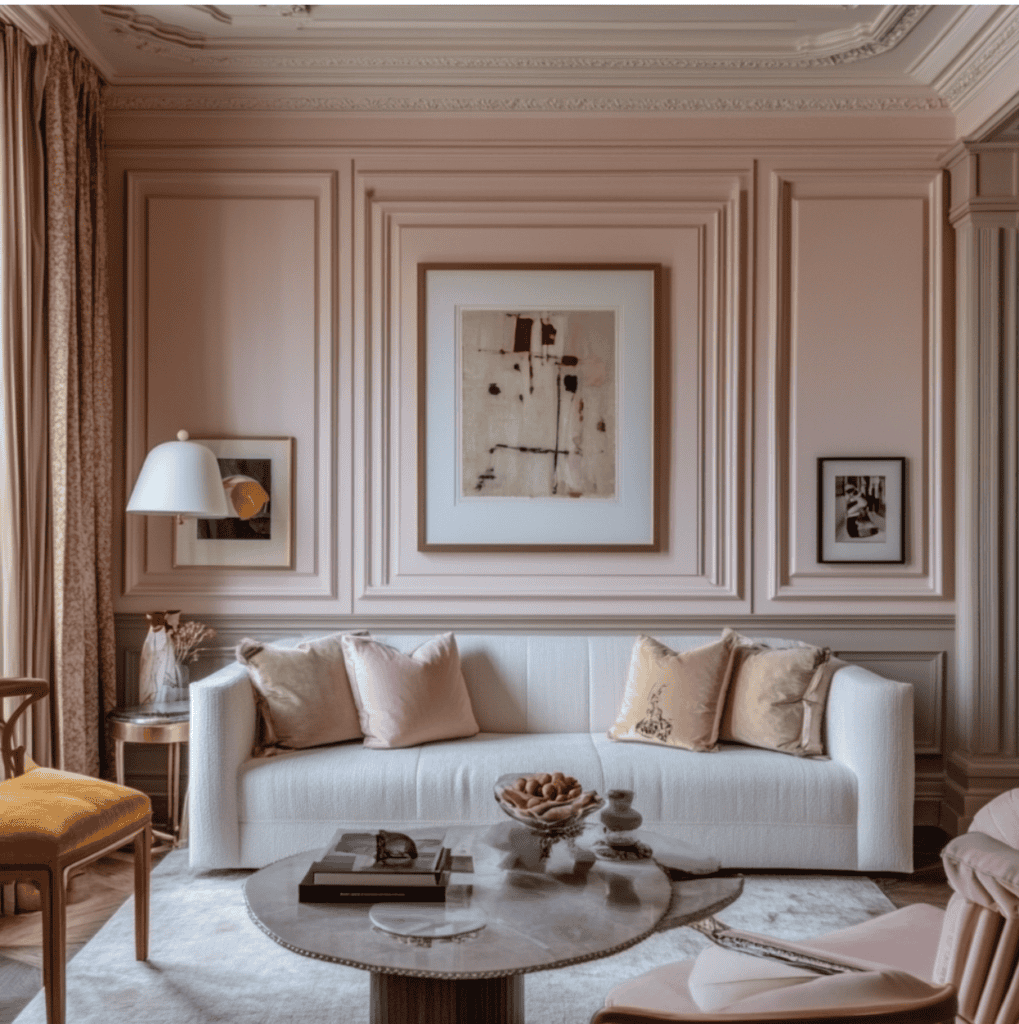
Another way to take advantage of your living room’s vertical space is by installing another architectural feature, such as picture frame molding. If you’re feeling crafty, it’s fairly easy to DIY over a free weekend.
Final Words
Whether you’re dealing with a compact city apartment or a cozy corner in a larger home, designing a small living room isn’t about limiting your ideas, but about getting clever with them. Every inch counts, but so does every texture, color, and shape.
So go ahead, play with the layout, lean into light, experiment with color, and embrace those quirky angles. Your small living room has big potential, and you’ve got all the tools to make it shine.

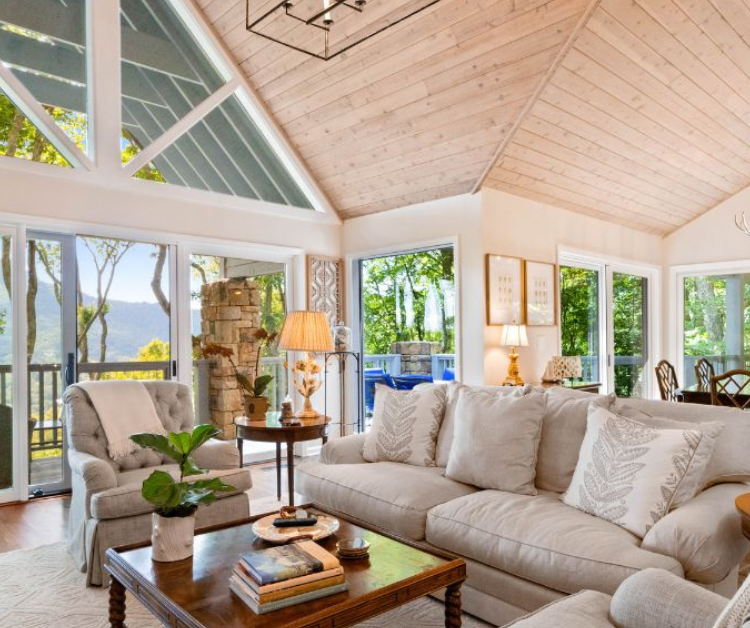
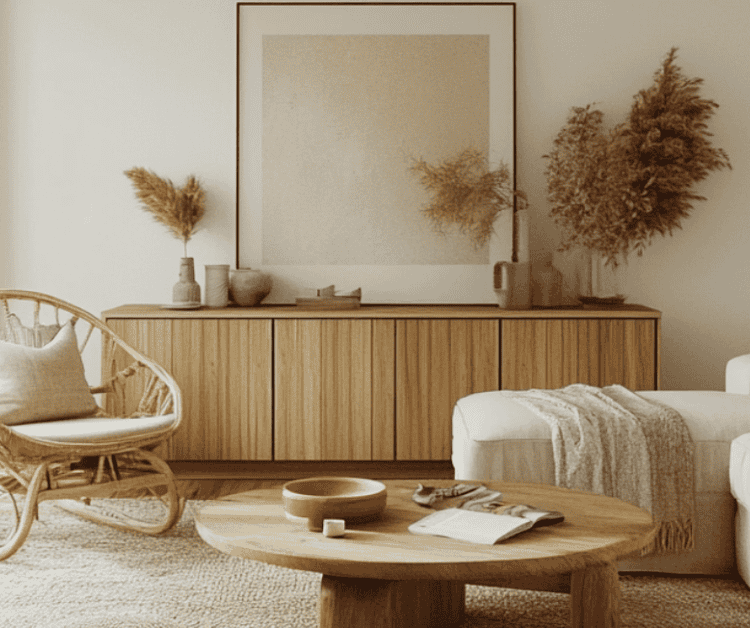
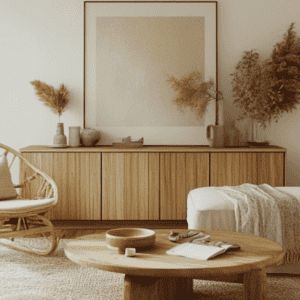
Leave a Reply